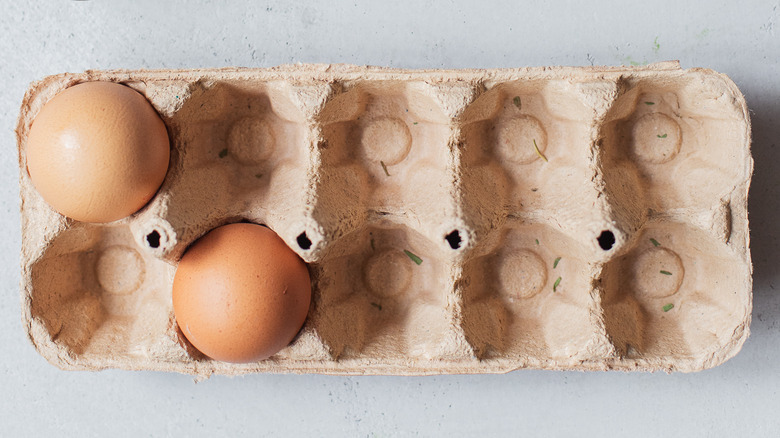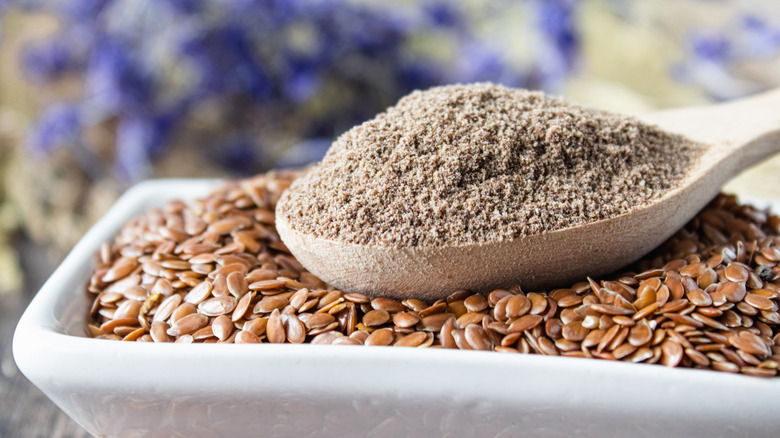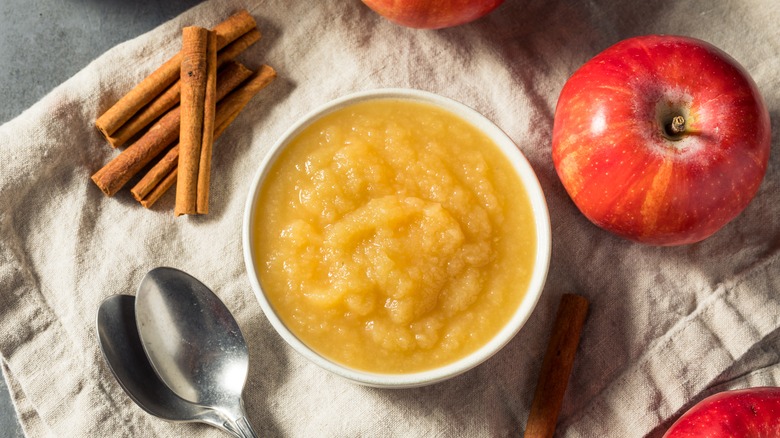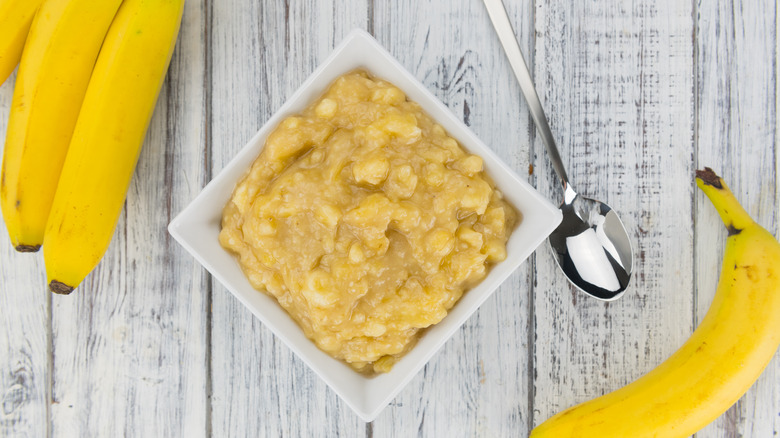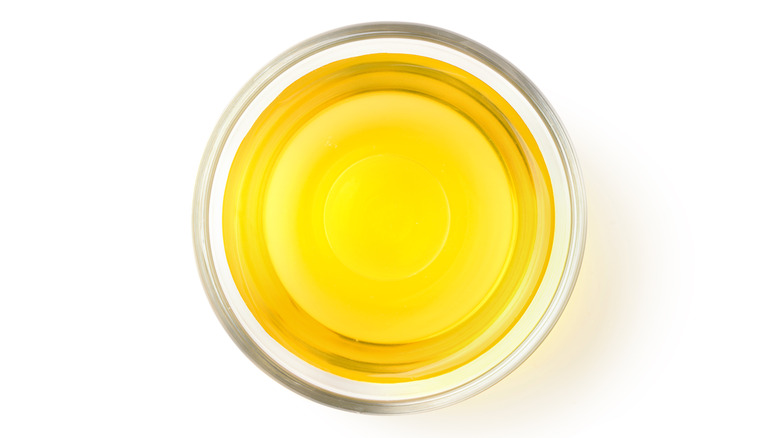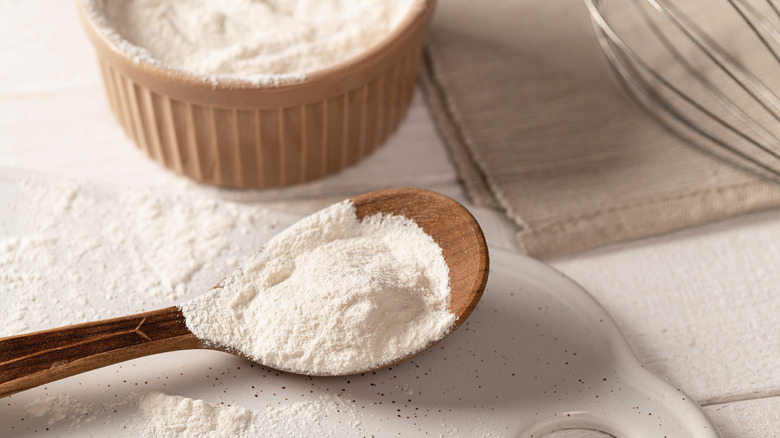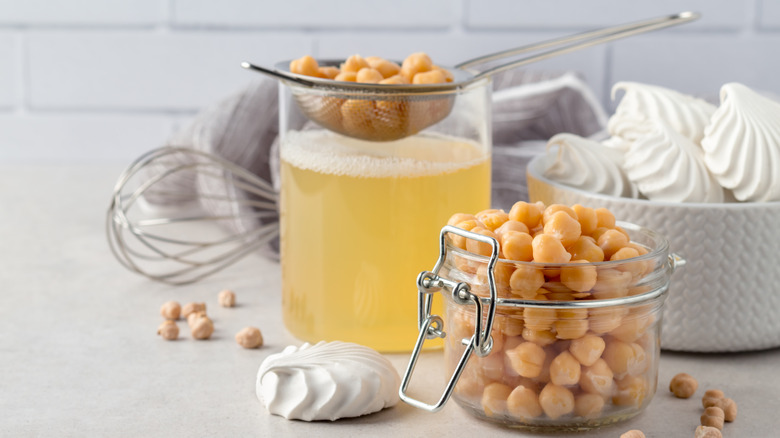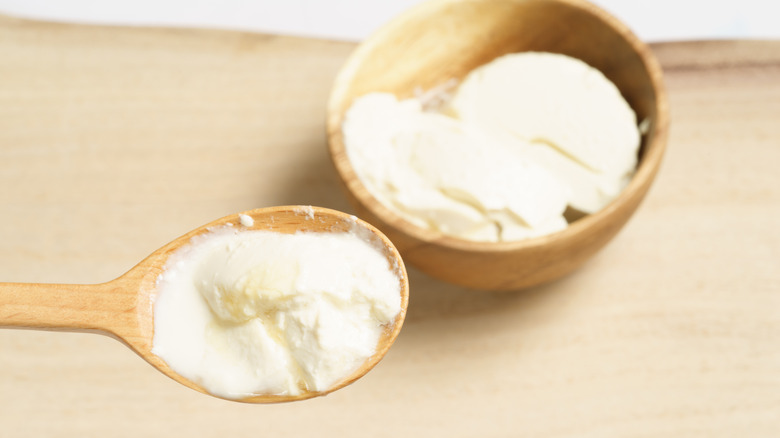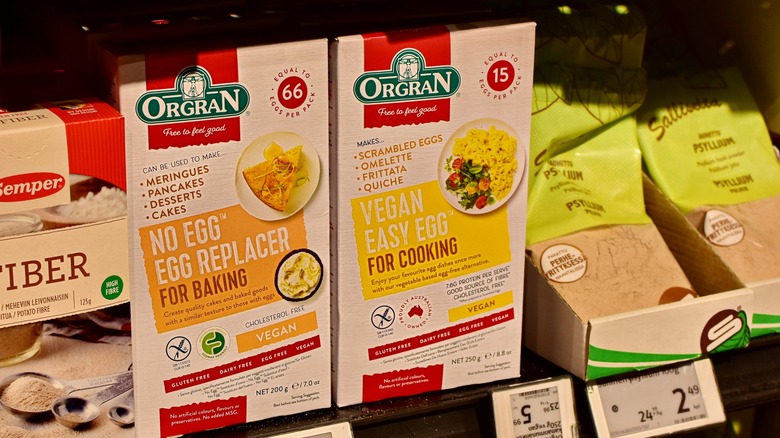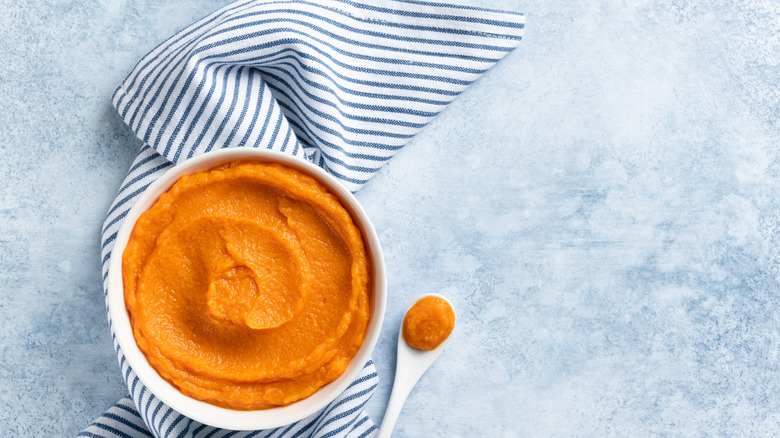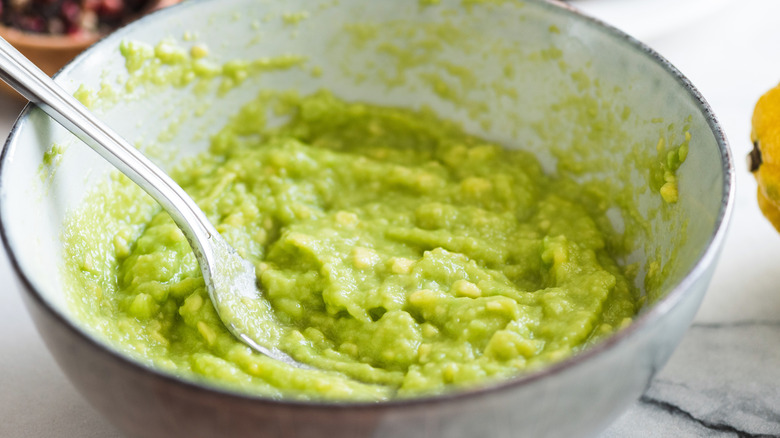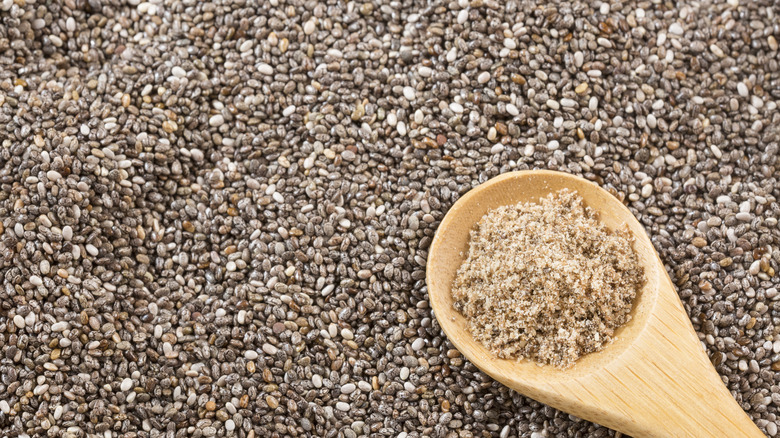The 15 Best Egg Substitutes To Use When Baking
So, you're making a batch of baked goods and need to execute them without eggs. Maybe someone in your family has an allergy, maybe you are vegan, or perhaps you simply ran out. Whatever the reason, there's no need to worry as numerous foods can successfully replace eggs in a recipe.
First, consider the actual purpose of eggs in baked goods; they tend to moisten, strengthen, or leaven the pastry in some way (via Happy Egg). This is why entirely skipping out on eggs without using a replacement is asking for trouble. You want moisture so the dessert isn't dry and structural integrity so it holds shape. Meanwhile, when eggs act as a leavening agent, they vitally assist the rising process so the baked good isn't overly dense.
The good news is that once you determine how the egg in your recipe contributes to the result, it's easier to determine which option on this list is best for you. Some of the stand-ins have specific functions like moistening, while others are well-rounded substitutes.
1. Ground flaxseed
Making a paste using water and ground flaxseed to replace eggs is one of many healthy swaps so you can have your cake and eat it, too. The correct proportion for this clever stand-in is 1 tablespoon of ground flaxseed per 3 tablespoons of water. This quantity covers you for only one egg, so if your recipe calls for several eggs, adjust the amounts. Add the flax and water mixture to the recipe at the same point that you would add the eggs. If you only have whole flaxseed, just make sure to grind it up first.
Bear in mind that flaxseed has an earthy taste, so this substitute works best for desserts with similar attributes — think nutty peanut butter cookies or hearty oatmeal bars. The flaxseed paste is both a binding agent and a creative way to add more fiber to your diet. Aside from fiber which is excellent for digestion, flaxseed also benefits the heart (via WebMD).
2. Whey protein
Whey powder is an ideal alternative if you cannot use eggs in your baking but want something with a similar makeup, according to Think USA Dairy. Like eggs, whey powder is high in protein and supplies structure to the baked goods you're making. For this approach, create a paste by adding water and oil to the whey powder; this works best since eggs contain a large percentage of water that you should compensate for when replacing them.
Think USA Dairy reports this neat method is appropriate for pastries such as brownies, cheesecake, fillings, cakes, and more. You'll need a kitchen scale to guarantee the most accurate outcome with this substitution. When measuring by weight, one large egg is roughly 2 ounces, so you will need approximately the same amount from the paste. Preferably, use a ratio of 15% whey, 10% oil, and 75% water for each egg. This technique produces pastries that have an impeccable texture and stay fresh for a longer duration.
3. Applesauce
For an easy baking ingredient swap everyone should know, try replacing eggs with applesauce. Whether you are in a pinch or just want to try something new, this practice works perfectly. Using store-bought applesauce is an effortless way to accomplish this hack. Another option is to make applesauce from scratch if you have the time. While it might sound tedious, it is quite straightforward and tastes divine.
Whether you're using homemade or jarred applesauce, the proportion for using it as an egg replacement is the same every time. The ratio to aim for is ¼ cup (or 4 tablespoons) of applesauce for one whole egg. Depending on the type of baked good you create, you might prefer to use unsweetened over sweetened, but either will do. Some sweetened applesauce contains cinnamon too, which alters the flavor profile of your sweet treat. In contrast, Mott's unsweetened applesauce only has apples and vitamin C, so it has a milder taste.
4. Arrowroot powder
Arrowroot powder is a solid stand-in for recipes where the egg is necessary to bind and create a softer texture. However, it will not assist the leavening process, so only use it in recipes where a leavening agent is already present (via Sub4health). A perfect example would be a cookie or brownie recipe that contains baking powder or soda. The ideal ratio is to mix 3 tablespoons of warm water with 2 tablespoons of arrowroot powder to create a slurry-like mixture. You may want to prepare this at the start of your recipe, as the mixture does best once it sits for a while and has time to become gelatinous.
Bob's Red Mill reports that arrowroot powder is a staple in gluten-free cooking and baking. It improves the crumb structure of your baked goods so they don't fall apart. Meanwhile, it also ensures that the bread or cake is pillowy and tender, so what's not to love? This fill-in comes in especially handy when baking a light-colored sweet treat because arrowroot starch is white and won't alter the confection's color.
5. Mashed bananas
Utilizing mashed banana in place of an egg is one of the brilliant cooking tips we learned from our parents. This trick is convenient because bananas are a common food in the average kitchen, so if you need a quick fix, it's easily on hand. One positive benefit of this swap is that bananas are naturally sweet, so you don't have to worry about it negatively affecting the taste of your baked goods. On the flip side, if you are baking a large batch, the banana might shine through and overpower the other ingredients, so keep that in mind if that's not the flavor profile you want.
For this substitute, just use one banana for every whole egg your recipe needs. Make sure to mash the banana before incorporating it into the recipe so that it doesn't cause lumps or stringy bits to appear throughout the batter or dough. Using a potato masher or a fork gets the job done in no time.
6. Vegetable oil and water
Vegetable oil and water might just be one of the best quick fixes when you're missing an ingredient like eggs. Since many recipes for baked goods already call for these components, there's a high chance you have them on hand and maybe even out on the counter. If your recipe only requires one egg, you're in luck because all you need to do is measure out ¼ cup (or 4 tablespoons) of vegetable oil — no water is necessary. However, if the baking formula needs more eggs, there is a mixture you can make from vegetable oil, water, and baking powder that works like magic.
As reported by Children's Hospital Los Angeles, you can create an allergen-free mixture by blending 1 ½ tablespoons of water and equal parts oil, with 1 teaspoon of baking powder for every egg you need. Make sure the baking powder dissolves in the mixture to avoid introducing unwanted lumps to the batter or dough. Use a fork or whisk to break up the clumps if any form. This is a terrific hack for recipes that need leavening since baking powder is involved.
7. Xanthan gum
Xanthan gum is a great substitute for eggs in baking formulas that need a leavening boost or added structural support. This ingredient won't necessarily do anything in the moisture department, so try using it in recipes where that aspect is covered (think pumpkin bread or blueberry pancakes). You can typically find xanthan gum in the baking aisle of your local grocery store; it often comes in a bag since it's a powder. This ingredient is white, so you don't have to worry about it changing the appearance of whatever sweet treat you're whipping up.
To use this ingredient in your baked goods, make a slurry first rather than incorporating it dry into the batter. Using the correct proportions of xanthan gum and water is essential. Specifically, ¼ teaspoon xanthan gum with ¼ cup water yields the best outcome to substitute one egg. Luckily, the ratio is simple, so it is easily adjustable if you need more than just one egg.
8. Aquafaba
If you're looking for a surprising ingredient you didn't realize you can swap for eggs in baked goods, try aquafaba. Simply put, it is the liquid you find in a can of chickpeas — yes, the stuff you usually pour down the drain. Once you whip it up, the thick gloop transforms into a consistency that's impressively similar to whipped egg whites. It even turns white like egg whites do when whipped. However, you can also use aquafaba to replace whole eggs in recipes. This is why chickpea water is an excellent vegan alternative that will make you forget about the standard ingredient.
To make a replacement for a whole egg, McCormick suggests using 3 tablespoons of liquid. On the other hand, you only need 2 tablespoons for an egg white. Be sure to measure the aquafaba before whipping it for maximum results. You'll love this replacement because it makes your sweet treats airy, and the flavor is mild as long as you use canned chickpeas with no added salt.
9. Silken tofu
Silken tofu has a similar makeup to eggs as far as its consistency and protein composition, which is why the TikTok favorite makes a perfect egg substitute. People use it for all sorts of foods, from hearty main course dishes to sugary sweet treats. When it comes down to it, tofu is virtually flavorless, which is good in this case as the flavor of the confection remains just as it would with eggs. Accomplish this healthy baking shortcut by incorporating ¼ cup of silken tofu per egg in your desserts.
A blender comes in handy with this ingredient swap because you'll want to mix it until it's velvety smooth before adding it to a recipe. Silken is superior to regular tofu for this approach because the latter is pressed, producing a far denser result. So, save yourself time and hard work by picking up some silken tofu — you'll be grateful you did.
10. Commerical egg substitutes
If you haven't come across the products on store shelves, there are various commercial egg substitutes to use in your recipes. Several companies make vegan imitation egg products, which is likely how the next generation may order its eggs. Aside from whipping up vegan omelets, you can also use them in baking projects. Products like the vegan Just Egg looks more like polenta if you use it for scrambled egg dishes. However, when incorporated into a baked good, you can't tell that regular eggs weren't utilized.
Some brands produce a liquid version, while others come in the form of a powder. The measurement for this swap will depend on which commercial egg replacement you buy, so just follow the directions on the package. This solution is ideal for people who must refrain from using eggs in their diet for personal or health reasons. With that said, if you just happen to run out of eggs you might not have this product at your disposal. Now that you know about it, it may be worth stocking in your pantry.
11. Pumpkin puree
Pumpkin is undoubtedly no stranger to the world of desserts; most of the time, bakers use it to give sweet treats a fall-like essence. However, vegan chef Gabrielle Reyes' favorite pumpkin baking hack is genius. Reyes brings pumpkin into play by using it as an egg replacement. This is a phenomenal idea because pumpkin puree is both easily accessible and also high in fiber and essential nutrients (via Healthline).
After all, pumpkin falls under the umbrella of superfoods, per Cleveland Clinic, so it must have some super qualities, right? To use the pleasantly orange pulp in your baked goods, measure out ¼ cup of pumpkin puree for every egg your recipe requires. Then, incorporate it into the batter at the same step in the mixing process that you'd be adding the eggs.
The only downside is that the pumpkin will slightly modify the hue of your confection. Although this tidbit might not bother everyone, it is still worth noting because the bright orange color is hard to miss. Of course, if you're making a cake that ultimately needs to be stark white, pumpkin puree isn't your pick of the litter, but luckily other options on this list will do.
12. Mashed avocado
Did you know that you can use avocado instead of butter and numerous other ingredients in baking? From oil to sour cream to eggs, avocado is not only versatile, but it also provides essential nutrients (via Harvard Health). So, by using it to replace the eggs in a baking formula, you're also adding nutritional value. It's easy to use this hack; simply take the avocado and smash it into a spread-like consistency. You only need 2 to 4 tablespoons of avocado for every egg in the recipe. Try starting with 2 tablespoons and adjusting by adding a couple more tablespoons if the consistency of the dough or batter seems a bit off.
This practice is wonderful since avocados have a subtle taste, which gets overpowered by other ingredients like sugar or spices in the final baked good. Another plus is that the moisture in avocados does a fantastic job of turning your desserts into fluffy delights. Finally, to preserve the softness of the baked goods and prevent them from burning, try lowering your oven temperature by roughly 25% when using this ingredient swap.
13. Vinegar and baking soda
If you're on the lookout for an egg swap that successfully works as a leavening agent too, look no further. You'll be glad to learn that mixing vinegar and baking soda produces a very interesting outcome. Combining these two standard household products creates a chemical reaction that will take your sweet treats to new heights, literally. Yes, with this combo, you can skip the eggs entirely, just like with this old-fashioned wacky cake recipe. The cake is egg-free and calls for 1 teaspoon of baking soda and 1 tablespoon of white vinegar to give it some lift.
When examining the Children's Hospital Los Angeles baking substitution guide, those respective amounts roughly equal one whole egg. If you only have baking powder instead of soda, don't worry. Use 1 teaspoon of baking powder and add 1 tablespoon of water with the tablespoon of vinegar. Whether you want to create fluffy muffins or airy biscuits, this simple trick is a game changer.
14. Chia seeds
Learning to cook with chia seeds can be intimidating if you aren't familiar with them. However, it isn't as complicated as it may seem, and there are numerous ways to incorporate these nutritious seeds into your diet. Using chia seeds as a stand-in for eggs is just one of the many possibilities. To make it easier on yourself, use ground chia seeds and mix them with water before adding them to baked goods. The mixture thickens as it sits, so be sure to give it a bit of time to gel up first.
The correct ratio to aim for is 1 tablespoon of ground chia for every 2 ½ tablespoons of water. This amount holds the fort for one egg, so modify it as needed. The color of the seeds is one matter to note when working with them in general, but especially with your beloved bakes. Ground chia is nowhere near white or transparent; it's rather dark and speckly looking. This is no problem for chocolate cake, but it is something to consider if you're making a light-colored sweet treat.
15. Mashed sweet potato
Baking cookies with unexpected ingredients is always a fun way to experiment and surprise whoever is eating them. In this case, we're especially intrigued by the fact that sweet potatoes make a suitable egg replacement. Yep, mashed sweet potatoes are successful because they work as a binder, holding the remaining ingredients together to prevent a crumbly outcome. Not only that, but the vegetable naturally contains water, meaning that its moisture can positively affect baked goods.
This swap is perfect for those straying from dairy or gluten products. Like pumpkin puree, taking advantage of sweet potatoes only has one downfall: their color. If your desserts need to have a specific appearance, adding orange tones to the batter might not be ideal. However, with simple treats like brownies or pancakes, the pros clearly outweigh the single con. To bring this method into effect, use 3 tablespoons of cooked sweet potato mash for every egg the recipe requests (via Sub4health).
